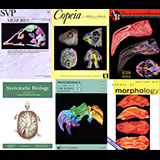 |
|
Wallace and coauthors recently described the skull of a new Triassic cynodont from the Ischigualasto Formation of Argentina. Their phylogenetic analysis suggests that Pseudotherium argentinus may lie just inside or just outside of Mammaliamorpha. To further investigations of this important lineage, the authors have made the high-resolution X-ray CT data of the holotype available here on DigiMorph.
[more...]
|
 |
| More than 300 Publications Now Cite DigiMorph Data! | 2019-01-28 12:00:00 |  |
| Did you know that more than 300 peer-reviewed publications now cite data from DigiMorph.org? Everything from computer rendering algorithms to sabertooth cat evolution. And according to Google Scholar, these publications have been cited more than 8500 times, with an h-index of 53! Here is a sampling of journal covers that DigiMorph data have graced, and you can click here to see a full list of publications.
[more...] |
 |
| Moroccodiscus smithi, a New Cyclocystoid | 2017-10-04 12:00:00 |  |
| Cyclocystoids are enigmatic extinct echinoderms with a circular, flattened morphology. Most specimens are known from Middle Ordovician to early Carboniferous rocks in Laurentia and Baltica. However, Reich and coauthors recently reported a new species, Moroccodiscus smithi, from the Ordovician of Gondwana. These specimens are preserved as molds within concretions; HRXCT scanning makes it possible to render them as positive digital casts. Learn more about this cyclocystoid by reading the DigiMorph account.
[more...] |
 |
| Three New Species of Thorius | 2016-11-15 12:00:00 |  |
| In 2016, Parra-Olea and coauthors published the results of a decades-long study of tiny salamanders from Oaxaca, Mexico. Thorius was first discovered in the 19th century, but populations have declined dramatically in the last 30-35 years. It may, in fact, be the world's most endangered genus of amphibians. In this study, published in PeerJ, the authors describe three new species and redescribe two species of Thorius -- and all five species can be found here on DigiMorph!
[more...] |
 |
| Spathorhynchus fossorium, Fossil Amphisbaenian | 2016-07-29 12:00:00 |  |
| Amphisbaenians are enigmatic, limbless, fossorial squamates whose phylogenetic relationships are poorly understood. A new paper by Müller and coauthors in the Journal of Anatomy examines in detail the cranial osteology of Spathorhynchus fossorium, the oldest-known well-preserved amphisbaenian, from the Eocene Green River Formation of Wyoming. This study suggests that some 'primitive' characters may in fact be synapomorphies of an extinct Paleogene amphisbaenian clade.
[more...] |
 |
| Nodosaurid Ankylosaur, Pawpawsaurus campbelli | 2016-03-23 12:00:00 |  |
| A new paper by A. Paulina-Carabajal, Y.-N. Lee and L.L. Jacobs explores the endocranial morphology of Pawpawsaurus campbelli from the upper Albian Paw Paw Formation of Tarrant County, Texas. Using high-resolution X-ray CT data, the authors help to fill critical gaps in our knowledge of ankylosaurian cranial neurovascular passages, morphology of the inner ear, and nasal cavities. Learn more about what they found by reading the DigiMorph account.
[more...] |
|
|

